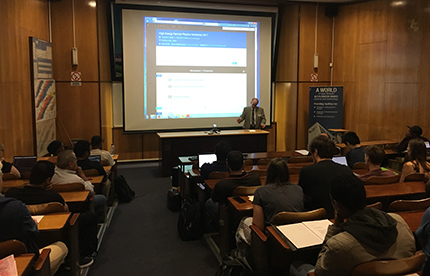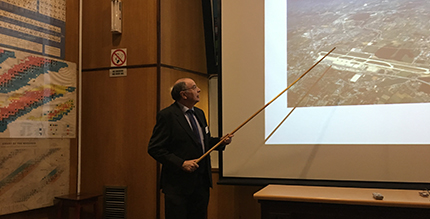High Energy Physics workshop inspires young talent
- Wits University
Workshop included an overview of the exciting results coming from astrophysics and how future experiments can shed more light on these results.
The 3rd High Energy Particle Physics workshop took place at iThemba LABS, Gauteng (former Schonland) February 1st to 3rd. This year’s edition has seen the number of registered students from all over the country increase to 45. The goal of this workshop was to give opportunity for students and young researchers to give presentations and to write proceedings. Morning plenary sessions, followed by 15 minute presentations, was the successful format across our three days. The topics covered are high-energy theory, high-E astrophysics and phenomenology (heavy ions, pp, ep, ee collisions), and experimental results from the Large Hadron Collider (LHC) at the European laboratory CERN.
 The workshop was opened by Professor Helder Marques, Dean of the Faculty of Sciences and the Chairman of the South Africa – CERN consortium (SA-CERN). Dr. Simon Mullins welcome the participants on behalf of iThemba LABS. Professors Alan Cornell and Bruce Mellado gave an overview of the scope and structure of the workshop, as co-Chairs of the Organizing Committee.
The workshop was opened by Professor Helder Marques, Dean of the Faculty of Sciences and the Chairman of the South Africa – CERN consortium (SA-CERN). Dr. Simon Mullins welcome the participants on behalf of iThemba LABS. Professors Alan Cornell and Bruce Mellado gave an overview of the scope and structure of the workshop, as co-Chairs of the Organizing Committee.
Introductory lectures were delivered by Dr Andrea Knue, from the Max Plank Institute for Physics, Munich and Jong Soo Kim from the Korean Institute of Basic Science. Leading members of the SA-CERN consortium such as Dr. Zinhle Buthelezi, Dr. Siegfried Forstch, Dr. Deepak Kar, Dr. Betty Kibirige, Dr. Will Horowitz, Dr. Xifeng Ruan and Professor Elias Sideras-Haddad were present at the event.
A delegation from the recently established Botswana University of Science and Technology (BIUST) was present at the workshop. The School of Physics of BIUST has shown strong interest in establishing collaborative links with South African institutions in projects pertaining to High Energy Physics.
High-energy collisions of heavy ions produce high density and high temperature state of matter that replicates the conditions of the Early Universe when quarks and gluons were not confined in the state of matter we observe today. The ALICE experiment at CERN has provided many surprising results concerning the investigation of the production of particles in this complex medium. This has helped to improve the theory of interactions considerably. More surprising results are expected in the future.
Based on features observed in the data taken by the experiments at the Large Hadron Collider, scientists from the Wits Experimental High Energy Physics and the Mandelstam Institute of Theoretical Physics in collaboration with scientists in India and Sweden, formulated the Madala hypothesis. The Madala boson is a type of boson that includes interactions with the Higgs boson discovered by the Large Hadron Collider experiments in 2012. The Madala boson is hypothesized to connect with Dark Matter in the Universe via a new intermediate boson. Data taking is resuming in June 2017 and will last till the end of 2018 followed by a two-year break. We are very excited to explore the predictions made by this hypothesis. The observation of new bosons would signify a major discovery in physics.
 Professor Sergio Colafrancesco and Dr. Geoff Beck, from the School of Physics, gave an overview of the exciting results coming from astrophysics and how future experiments, such H.E.S.S., CTA and the SKA can help shed more light on these results. The use of both direct collider searches at the LHC and astrophysical probes is vital in uncovering the nature of Dark Matter in the Universe. The search for gamma-ray emission via Dark Matter annihilation in astrophysical contexts is one of cleanest ways to probe the physics of Dark Matter. The current data were discussed in terms of the various models, including also the recently formulated Madala hypothesis.
Professor Sergio Colafrancesco and Dr. Geoff Beck, from the School of Physics, gave an overview of the exciting results coming from astrophysics and how future experiments, such H.E.S.S., CTA and the SKA can help shed more light on these results. The use of both direct collider searches at the LHC and astrophysical probes is vital in uncovering the nature of Dark Matter in the Universe. The search for gamma-ray emission via Dark Matter annihilation in astrophysical contexts is one of cleanest ways to probe the physics of Dark Matter. The current data were discussed in terms of the various models, including also the recently formulated Madala hypothesis.
The SA-CERN consortium takes broad impact in the South African context very seriously. Human capacity and skills development play a critical role in the program. So does technology transfer. The exploration of the physics of very short distances (which is achieved accelerating and colliding particles at very high energies) involves massive technological challenges, hence helping industry to produce more sophisticated devices. This is the case of advanced electronics in South Africa. The upgrade of the electronics of the LHC experiments poses formidable technological challenges. South African industry has manufactured an electronics board for the upgrade of the ATLAS detector. The production of the board proved a challenge because of the high density of planes, as well as the extreme precision needed to link up the electronic circuits throughout the 16-layer board. The result in product was a milestone for the South African electronics industry in that this board is the most sophisticated produced to date.
